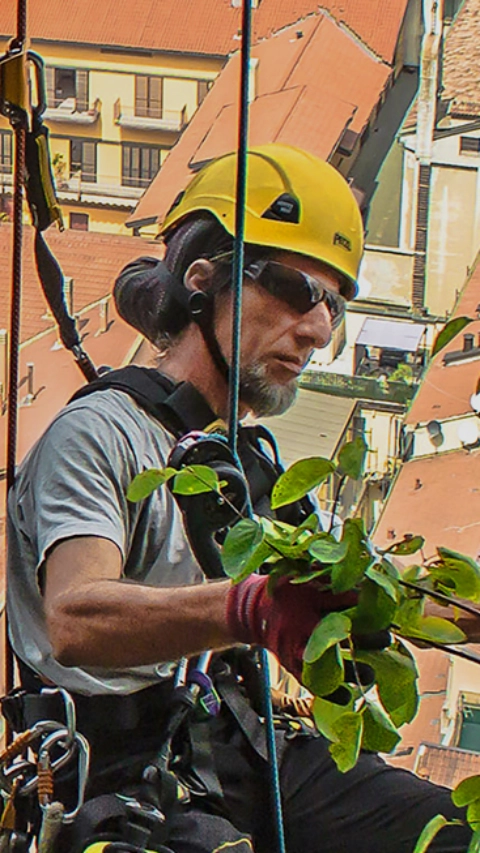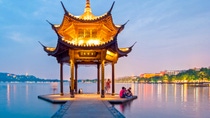Media
Above and beyond
People are being drawn into the cites. Living space is growing scarce. How cities can continue to grow in the future and remain liveable at the same time.
Imagine a sunny morning in the year 2050. You are in a tower block. You look down from the panoramic windows on the top floor: Robots are cleaning the façade and carrying out repairs. Further down, a new building module is being pushed into an opening in the façade. It is an urban farming element: it can be used to grow vegetables and breed fish and chickens directly in the building. Rainwater is collected on the roof and service water is treated. A building membrane converts carbon dioxide into oxygen, and solar panels and wind turbines produce energy. Sounds crazy? Not according to the plans of the architectural firm WOHA, which has come up with the high-rise of the future. "We think that the ultimate sustainable building is a self-sufficient building. Thinking on a large scale, we should be aiming for self-sufficient cities," says Richard Hassell, co-founder of WOHA.

The Singapore-based architecture firm has won many awards for its tropically open and sustainable architecture. One striking example is the Parkroyal on Pickering in Singapore, a hotel that combines architecture and nature.
The club of megacities
Growing megacities, sustainability, quality of life: these topics are increasingly important for city planners and architects. With around 38 million people, Tokyo is number one in the rankings for the world’s most populated cities, followed by Delhi, Shanghai and Mexico City. The Japanese metropolitan area has been a member of the exclusive club of megacities (defined by the United Nations as a city with more than 10 million inhabitants) since 1950. The only other member at that time was New York, which has now moved down to ninth place. Today, there are over 37 megacities worldwide, and it is expected that more and more people will continue to move to cities in the future. According to U.N. forecasts, there will be more than 43 megacities by 2030, most of which will be in emerging markets

The world will need up to 2 billion more apartments in the next 80 years because of rapid urbanization. As cities do not have unlimited ground space to build on, and existing space is increasingly expensive, densification is the new buzzword. “The future of humanity depends on the benefits proposed by vertical densification in cities. This concept reduces land use and the energy required to build and maintain a horizontally expanding city,” says Professor Antony Wood from the Council on Tall Buildings and Urban Habitat (CTBUH) in Chicago. This non-profit organization studies tall buildings and their architecture. The CTBUH office is based in an historically significant location: Chicago is considered the birthplace of the skyscraper.

After the Great Chicago Fire of 1871 and a rapid increase in land prices, new buildings steadily started creeping upward. This was made possible by high-strength steel. Crash-proof elevators invented by the Otis company in 1853 also made top floors a more attractive prospect. This was followed by height records being set, primarily in New York, thanks to steel skeleton structures. Today, New York City boasts more than 260 buildings with a height of over 150 meters. This is only exceeded by Hong Kong, which has about 350 skyscrapers.
But the current record-holder for highest building is in Dubai, United Arab Emirates: the Burj Khalifa with a height of 828 meters and 162 stories. Special equipment was required to construct such an extremely tall building, such as tower cranes and super high-pressure pumps, as well as appropriate material technology for the concrete. In the case of the Burj Khalifa, there were extremely stringent stability requirements.
“High-strength concrete was needed. The mixture had to have a pressure resistance of 80 Newtons per square millimeter, which is three times more pressure-resistant than the standard concrete used for house construction,” says David Bowerman, Regional Business Segment Manager at BASF in Dubai, who supervised the Burj Khalifa project. MasterGlenium products were used to make the 175,000 cubic meters of concrete that were needed. “These are the only concrete admixtures on the market that met the client’s requirements. They ensure rapid solidification and can be processed at temperatures of over 45 degrees Celsius – which is not an uncommon occurrence in Dubai in the summer,” explains the concrete expert. “Another challenge was that a pump had to transport the concrete mixture from the ground to a height of over 600 meters. That was a new record,” says Bowerman.

New gigantism
Innovative solutions clear the path to dizzying heights. Along with ultra-strong concrete, special large bored piles are also used to anchor super skyscrapers meters deep into the ground. And innovative cable-free elevators based on magnetic levitation technology transport residents up to the highest levels of mega towers at lightning speed.

It is neither the statics nor the foundation that truly limit height. “Most people think that the height of a building is limited by technical factors, but that’s not the case,” says CTBUH Executive Director Wood. A much more decisive factor is whether you are able to raise the necessary funds and obtain the necessary permits. The new hot contender in the race for the title of world’s tallest building is the Creek Tower in Dubai. Once it has been completed in 2020, the tower will loom about 1,000 meters above the ground thanks to BASF concrete admixtures. The construction costs for the mega tower are estimated to be around $1 billion.
New ideas for skyscrapers

The wooden skyscraper, the green apartment block and the floating skyscraper
The future of humanity depends on the benefits proposed by vertical densification in cities.”
Skyscraper expert Wood expects a real surge in the number of skyscrapers over the course of global urbanization. The record set in 2016 of 127 buildings higher than 200 meters completed worldwide was quickly surpassed just one year later with 140 new gigantic towers. Most of these were built in China. Wood is sure that skyscrapers are the ideal way to confront urban densification – not only because of their height, but also because they link together several levels of a city. “Things that are usually at ground level – for example, urban infrastructures or green spaces – will ideally continue onto and into the skyscraper, making the building an extension of the city.” The result of this will be vertical cities that grow upward into the sky, where living, working, and leisure go hand in hand. These new buildings are often designed as flexible modular structures that can be easily and cost-effectively adapted to the needs of their users.
Small but mighty
Unusual, mini modular solutions are being developed for cities with an extreme shortage of living space: The OPod Tube Housing project of Hong Kong architecture firm James Law Cybertecture converts concrete water pipes into micro-apartments with a living space of 9.29 square meters. The residential tubes can be stacked vertically and horizontally as needed.

Hong Kong is notorious for its lack of space and dense living conditions. This is where the term “mosquito apartment” came from: tiny living spaces only big enough for a mosquito. In Japan and Taiwan, the construction of micro-apartments to fill the smallest gaps is also booming. It’s a trend spreading all over the world. Micro-living should provide some relief for large European and North American cities in the coming years.
This way of living encourages a new form of cohabitation, which focuses less on private space and more on communal space. The space that we are lacking is shifted beyond the confines of our personal area. Communal areas on different levels and on the roof are just as much a part of all this as launderettes and swimming pools. The future of urban living is about sharing – not just cars, but also private and public space. At the same time, nature is being brought back into our living spaces. For example, leaves are already sprouting on the spectacular Tao Zhu Yin Yuan Tower in Taipei and on the Oasia Hotel Downtown in Singapore, which was named the world’s best skyscraper in 2018. This building designed by WOHA has a red aluminum grid façade, where tropical plants are gradually covering the hotel in a shroud of green. The building is a real eye-catcher that is also benefiting the microclimate.





